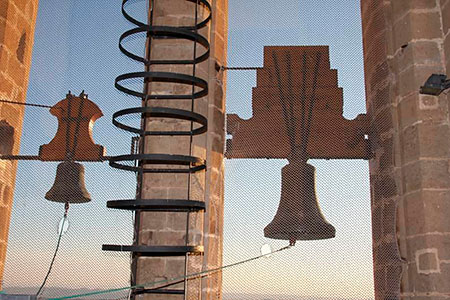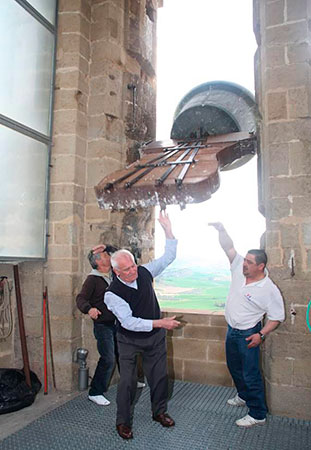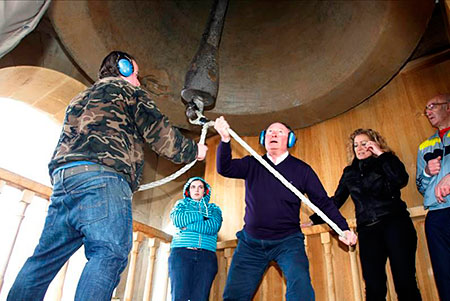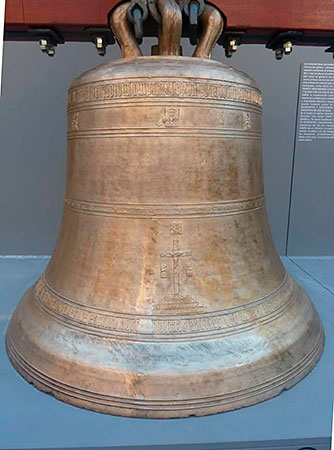12 June
lecture series
TOWERS AND BELLS
Bells: witnesses of local history
Miguel Bañales
Association of Bell Ringers of Navarre
The bells are mostly placed in the belfries of churches and the steeples of chapels and town halls. They can also be found in places as diverse as the interiors of convents and monasteries, railway stations, ships, stock exchange offices and sports stadiums where athletics events are held.
Their sound serves to transmit news to the members of a community. They inform us of religious and civil events of general interest. Until now, no faster communication system has been invented than bells to give news to the inhabitants of a locality.
Bells, as well as sending messages, convey emotions: of joy when they ring on the eve and on public holidays, of sadness when they inform us of the death of a person, or of alarm if they ring for a special event such as a fire.

Bell with a mixed shape and on the right an esquilon (church of San Saturnino de Artajona).
This musical instrument, although small in size, was known since ancient times and was adopted by the Catholic Church in the 5th century. It is believed that Saint Paulinus, bishop of Nola, had the first church bells cast in the region of Campania (Naples) around the year 400, taking his name from this region. Their use became widespread from 604 onwards thanks to Pope Sabinus, who ordered bells to be placed in church towers in order to gather the faithful.
The bells are made of bronze and bear inscriptions and drawings in relief made at the time of casting. The inscriptions provide information on the date of casting, the dedication of the bell and brief religious texts. The decoration is dominated by religious motifs as well as geometric and plant motifs. It is very common for the cross to be placed in the area visible from the street. The texts of the inscriptions were written in Latin until the 18th century, and later the language of each country was increasingly used.
There is no standardised typology of bells, although in the West we can distinguish:
- Esquilons: narrow and elongated, in the shape of an inverted champagne glass.
- Roman: wide at the top and bottom, in the shape of an inverted wine glass.
- Mixed: a mixture of the two previous shapes.
In some church towers we find carillons or carillons. This is the name given to the set of bells that can be used to play a melody. The sound is produced with the strike of a hammer activated from a computer keyboard or manually by the carillonist through an organ located on the leave floor of the bell tower. A carillon is considered a carillon if it has a minimum of 25 tuned bronze pieces. There are fewer than ten carillons in Spain; the closest to Pamplona are the one in the Andra Mari Church in Amurrio and the one in the Diputación Provincial de Zaragoza.
The sound of bells can be obtained in several ways.
If the bell turns:
- swinging or swinging (360º turn), although the latter is called swinging in other places.
- swinging or half-flying (180º turn), moving the bell in a horizontal line.

Ringing of bells in the church of San Saturnino in Artajona.
If the bell is fixed: by an internal strike with the language or clapper, or an external strike with a hammer or mallet.

Ringing of the Maria bell in Pamplona Cathedral.
Bells are called by a name related to their dedication, shape, size, or the ringing for which they are used.
|
Most outstanding bells |
|||||
|
Features |
Name |
Location |
Width |
Approximate weight (Tn.) |
Year |
|
World's largest |
Tsar Kolokol |
Pl, Kremlin (Moscow) |
6,14 x ,6 |
202 |
1735 |
|
Largest in Europe |
San Pedro |
Cologne Cathedral |
3,22 x ,20 |
24 |
1922 |
|
Major of Spain, unused |
Fat |
Toledo Cathedral |
2,93 x ,29 |
17 |
1755 |
|
Mayor de España, in use |
Maria |
Pamplona Cathedral |
2,58 x ,25 |
10,1 |
1584 |
|
Europe's oldest, unused |
Samson |
Museo Arqueol. Cordoba |
0,21 x .20 |
|
930 |
|
Oldest in Spain, in use |
Wamba |
Oviedo Cathedral |
1,30 x ,05 |
0,833 |
1219 |
|
The oldest in Navarre |
Gothic |
Tudela Cathedral |
|
|
1347 |
As Isidoro Ursúa, a scholar of Navarrese bells, points out: "the life of the villages was governed by the sound of the bell".
The bells, due to the privileged place where they are located, are the observers of the changes in the life of a town, witnesses of the events that have taken place in that place. Their most frequent traditional tolls are:
Daily religious tolls:
- Toque de oración, at dawn, which signalled the start of the working workshop .
- The Angelus, at midday, marked the lunch break.
- The evening prayer service at dusk, which announced the end of the workshop work day, the time to return home, have dinner and rest.
- Mass", either in the morning, at "misa primera" or in the afternoon.
Non-daily religious tolls:
- The death knell, which was played when the sick person was on the point of death. It was played so that the faithful would pray for the sick person and the dying person would receive Extreme Unction.
- Toque a muerto or a difunto, which differentiated between adults, by sex and class social. A distinction was also made if they were children (before receiving First Communion).
- Death and appointment of the pope.
- Death of a canon or bishop.
- Toque de rogativas, in which the bells were rung while the procession took place, asking for water for the fields or the cessation of a plague.
- Toque de fiesta.
- Ringing of processions.
- Ringing of the rosary. In Pamplona, on Saturdays in October, it is rung to attend the Slaves' Rosary.
- Toque de vísperas de fiesta.
- Toque de ánimas (ringing of the souls).
Civilian touches:
They were the responsibility of the town or council:
- Clock.
- A council: a summons to the villagers to deal with the general affairs of the town.
- Auzolán: used to congregate the villagers to work for the community.
- Auzolán: used to open and close the gates of the town.
- With fire.
- Grouping of livestock: ringing to remove the livestock from the houses and concentrate them in one place in the village to take them to graze on communal land.
- A rebato for a general alarm.
- Ringing of the arrival of the doctor or veterinary surgeon in the village, to warn of the time of enquiry.
- Alarm: in wartime, to warn of the arrival of the enemy or of important events such as the fall of a city or the end of the war.
- Curfew, used in the event of war or a temporary alert situation. It prohibits movement in the streets at nightfall.
- Ringing of the opening or closing of city gates.
- Toque de tormentas, tente nublo or of incantations. It took place between the cross of May (3rd) and the cross of September (14th), in some places every day, in others only on Sundays and in all when there was a risk of a storm. It was believed that the ringing of the bells destroyed hail, as the sound waves moved the air and prevented the water from turning to ice. The act of incantation consisted of ringing the bell(s) and saying prayers alluding to the devil, who was considered to be the author of the storm clouds, praying to God for deliverance from danger in order to disperse the clouds and prevent the destruction of crops. This ritual was performed in the bell tower, on a balcony of the tower or at the door of the church or Shrine of Our Lady of Fair Love. It was performed by a clergyman, sometimes accompanied by another person who rang the bell(s), paid for by the town council, council or a brotherhood. The bells were rung for the duration of the storm. The lightning from storms has caused numerous deaths among the conjurers (Larraga in 1683, Olcoz in 1693, Añorbe in 1675 and 1706, etc.).
- Toque de advertisement of the arrival of the king, or of the bishop.
- Toque de perdidos, used to guide the lost or to search for the lost.
Church bells were silent for three days a year, from the Gloria of Holy Thursday Mass to the Gloria of Holy Saturday. Instead, wooden rattles were used to call the services. This wooden instrument is shaped like a cross-section and has wooden hammers between the angles; when turned, the hammers strike the wooden planks to produce a very loud sound.
Pamplona will shortly be celebrating the 500th birthday of "la Gabriela", a bell cast on 28 July 1519 in the vicinity of the cathedral. This bell is the oldest of the eleven bronze bells hanging from the two towers of Pamplona Cathedral. It is located in the south tower, overlooking the cathedral's place .

Gabriela bell from Pamplona Cathedral, Romanesque in shape. The welded crack can be seen to the left of the cross.
It measures 1.67 m in diameter, 1.35 m high and weighs 2,480 kg. Its inscriptions are in Latin, in Gothic minuscule, although the date is in French except for the month, which appears in Spanish , and they run around its perimeter in three zones. The upper part reads quotation from the Epistle of Timothy (1 Tim. 1:17) and the date of its casting. In the central part the expression "Ave Maria, te deum laudamus" (Hail Mary, we praise you God). At the bottom, a text from the Gospel of Luke (Lk. 1:26-28) on the Annunciation of the angel Gabriel to the Virgin Mary.
It is undoubtedly the most decorated bell in the cathedral. It has fifteen drawings that are repeated and are on the upper part, all around the piece. They are scenes of Ecce Homo, the Crucifixion, the standing Virgin and Child, and Saint Michael. Towards the outside, in the central part, there is a Calvary cross. According to oral tradition, this bell cracked while being rung during the night of the change from the 19th to the 20th century. From then until 2010, when the crack was welded, it remained silent.
